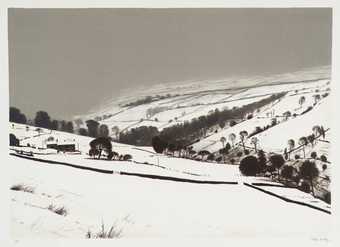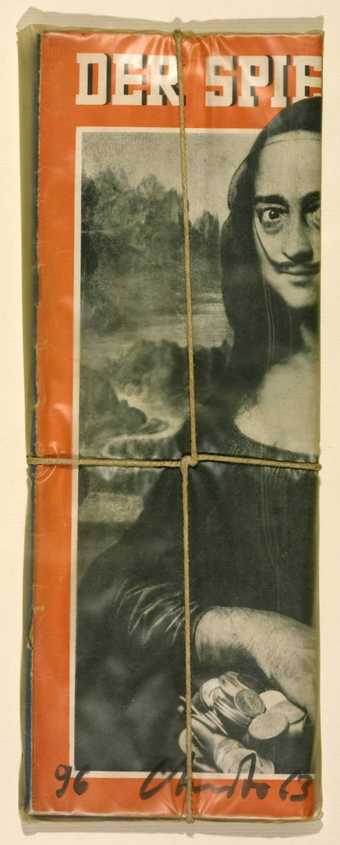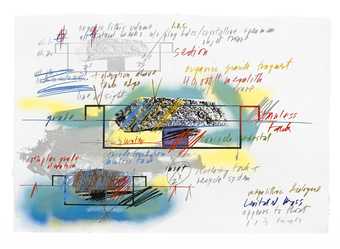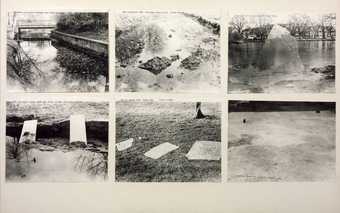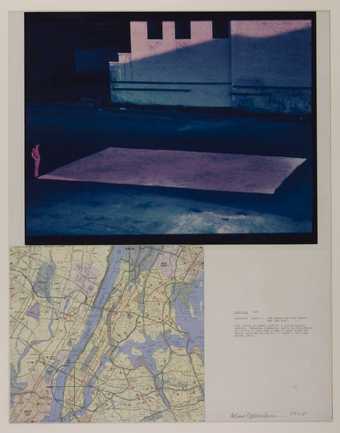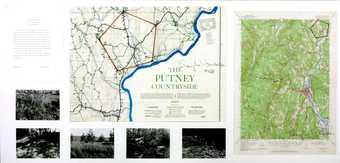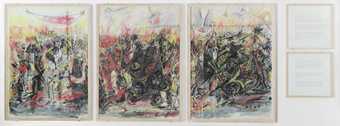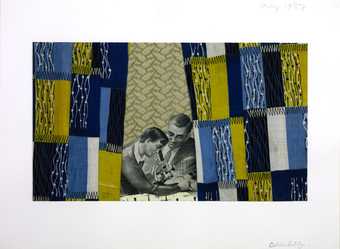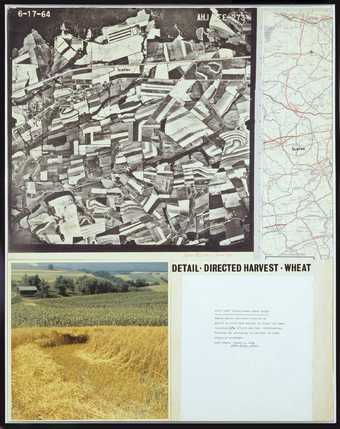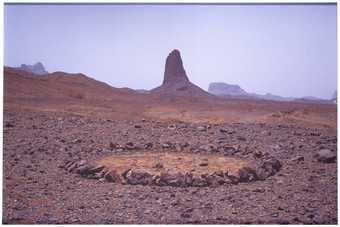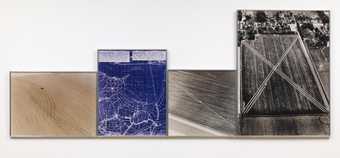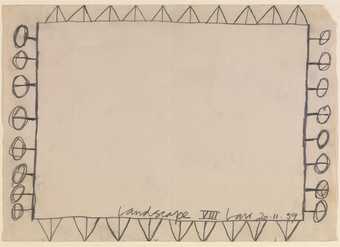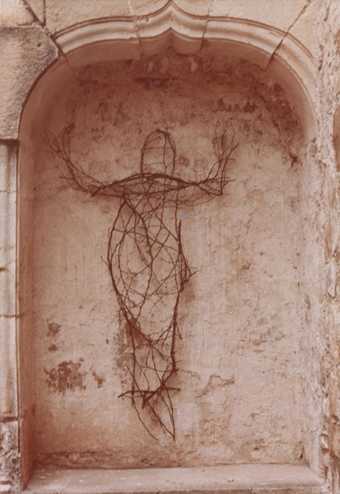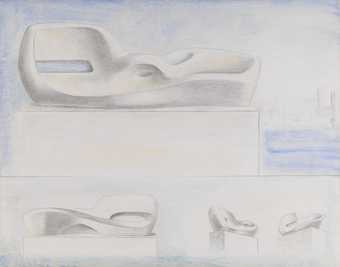
In Tate Modern
- Artist
- Christo (Christo Javacheff) 1935 – 2020
- Medium
- Crayon and fabric on paper
- Dimensions
- Support: 711 × 559 mm
frame: 727 × 574 × 51 mm - Collection
- Tate
- Acquisition
- Purchased 1971
- Reference
- T01581
Display caption
In 1970 Christo and Jeanne-Claude, partners both in art and life, started planning the installation of a vast orange fabric curtain across a valley in Colorado, USA. The project required collaborating with a network of local authorities, engineers, sponsors and assistants. This work is one of many drawing-collages Christo made in order to have its design approved and funded. Some of these sketches were included in the Systems Art exhibition organised by the CAyC in Buenos Aires in 1971. After a failed attempt, Christo and Jeanne-Claude successfully installed the curtain on 19 August 1972. It remained in position for 28 hours, until it had to be removed due to strong winds.
Gallery label, March 2022
Does this text contain inaccurate information or language that you feel we should improve or change? We would like to hear from you.
Catalogue entry
T01581 Valley Curtain (Project for Colorado) Rifle, Grand Hogback 1975
Inscribed 'Christo 1975' b.r.; 'VALLEY CURTAIN (PROJECT FOR COLORADO) RIFLE, GRAND HOGBACK 216 miles west from DENVER, 7 miles NORTH from RIFLE; SPAN 1250' 0" CURTAIN; WIDTH: 1375' 0" | HEIGHT: 195' 0"- 365' 0"' along bottom of drawing; 'MAIN SUPPORT: 27-20 FEET AND 40 FEET | CONCRETE FOOTING 100 CU. YDS. PULL OUT 2.500.000 LBS.' t.l.; 'COMBINATION OPEN SOCKET | AND CLIP', 'CABLE CONNECTION CLAMP' and 'see BOTTOM | DRAWING' t.c. The consulting engineer's drawings at the bottom also have several inscriptions, e.g. 'PRIMARY CABLE' and 'PICK-UP CABLE'
Collage (fabric and blueprints) and crayon on paper, 28 x 22 (71.2 x 56)
Purchased from Lambeth Arts Ltd. (Grant-in-Aid) 1972
Prov: With Lewis Kaplan, London, and Annely Juda Fine Art, London (purchased jointly from the artist); with Lewis Kaplan (Lambeth Arts Ltd.), London
Lit: Christo: Valley Curtain (New York 1973)
Christo embarked in the spring of 1970 on a project to erect a vast curtain of woven synthetic fabric across a valley in Colorado, suspended on a steel cable anchored to two mountain tops with foundations. After surveying eleven possible valleys he decided in August 1970 to choose Rifle Gap, Grand Hogback, seven miles north of Rifle and 216 miles west of Denver. He then set about obtaining permission from the owners of the site and commissioned a firm of consulting engineers, Lev Zetlin Assoc., Inc. to carry out a structural feasibility study. T01581 is one of a number of drawing-collages made in 1970-1 to show how the completed work would look and as a way of raising money to carry it out.
The artist has written (7 September 1974) that during the 28 months of preparation and work in progress before the realisation of the Valley Curtain, approximately 250 items were made of various sizes: 14 x 11in; 28 x 22in; 36 x 60in; 36 x 96in; and larger. These were in various media: collages, drawings, drawing-collages and 3D scale models. The first drawings and collages were made with imaginary landscapes, then with photographs (or drawings from photographs) of all the eleven valleys he found in Colorado, and finally of the actual valley to be used, at Rifle Gap, showing different views, angles etc. The photographs were always taken by someone else and are only a guide in the case of a drawing background; when the background appears to be a photograph, it is actually an enlarged photostat, retouched by himself and/or coloured. Many different documents were used in the drawings and collages, maps, surveyor's reports, two different engineering companies' calculations, weather reports and fabric samples. The drawings were intended first of all to convey the idea to the engineers so that they could understand what he wanted them to design and so that the building contractor could know what he was supposed to build. As the work of the engineers progressed, so did the drawings; whenever a structural modification was mutually agreed, the drawings took this into account. 'For instance, we started thinking there will be 7 upper connections (as your collage shows) the later drawings show is upper connections, because the Engineers decided to add 4 more upper connections.'
In T01581 detailed studies for the cable connection clamp circled in the main drawing are pasted on below. These are photostats of the original engineering drawings produced by the consulting engineers Lev Zetlin Associates, Inc., and can be compared with the later, revised drawing by the same firm reproduced on page 48 of Christo: Valley Curtain, a book which reproduces a large number of documents and photographs tracing the history of this project.
The first attempt to install the curtain was made on 9 October 1971, but a small gust of wind while it was being raised caused the fabric to unfurl prematurely and become lacerated on the equipment and rocks below. However, nothing daunted, the artist hired new engineers and building contractor and resumed preparations, until he finally had the satisfaction of carrying the project to completion on 19 August 1972. The curtain remained in position for 28 hours, when an over 60 m.p.h. gale made it necessary to start its removal.
The sale of the preparatory works for the Valley Curtain paid for 75% of the total cost of the project, the other 25%, being from the sale of early works and from lithograph commissions. Lewis Kaplan and Annely Juda Fine Art, who bought this and a number of other drawings from Christo, were amongst the cosponsors of this project.
Published in:
Ronald Alley, Catalogue of the Tate Gallery's Collection of Modern Art other than Works by British Artists, Tate Gallery and Sotheby Parke-Bernet, London 1981, pp.122-4, reproduced p.122
Explore
- emotions, concepts and ideas(16,416)
-
- formal qualities(12,454)
-
- diagrammatic(799)
- furnishings(3,081)
-
- curtain(250)
- countries and continents(17,390)
-
- USA, Colorado(15)
You might like
-
Peter Brook JANUARY Pennine Valley
1976–7 -
Christo (Christo Javacheff) Der Speigel Magazine Wrapped
1963 -
Michael Heizer Levitated Mass
1983 -
Bruce McLean Six Sculptures
1967–8 -
Dennis Oppenheim Salt Flat
1968 -
Douglas Huebler Site Sculpture Project, Windham College Pentagon, Putney, Vermont
1968 -
Art & Language (Michael Baldwin, born 1945; Mel Ramsden, born 1944) Gustave Courbet’s ‘Burial at Ornans’; Expressing a Sensuous Affection .../Expressing a Vibrant Erotic Vision .../Expressing States of Mind that are Vivid and Compelling
1981 -
Colin Self The Whispering Curtain (Or the Childhood of Orlando Gibbons)
1987 -
Dennis Oppenheim Directed Harvest
1966 -
Tracey Emin Monument Valley (Grand Scale)
1995–7 -
Richard Long CBE Sahara Circle
1988 -
Dennis Oppenheim Directed Seeding - Cancelled Crop
1969 -
Bob Law Landscape VIII
1959 -
Ana Mendieta Untitled (Silueta Series, Mexico)
1976 -
Dame Barbara Hepworth Project for Waterloo Bridge: The Valleys
1947

